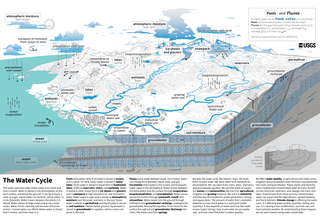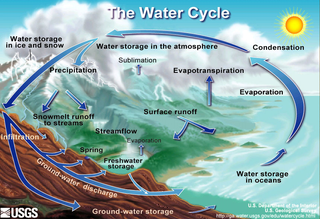
Hydrology is the scientific study of the movement, distribution, and management of water on Earth and other planets, including the water cycle, water resources, and drainage basin sustainability. A practitioner of hydrology is called a hydrologist. Hydrologists are scientists studying earth or environmental science, civil or environmental engineering, and physical geography. Using various analytical methods and scientific techniques, they collect and analyze data to help solve water related problems such as environmental preservation, natural disasters, and water management.

Evapotranspiration (ET) refers to the combined processes which move water from the Earth's surface into the atmosphere. It covers both water evaporation and transpiration. Evapotranspiration is an important part of the local water cycle and climate, and measurement of it plays a key role in agricultural irrigation and water resource management.

The water cycle, also known as the hydrologic cycle or the hydrological cycle, is a biogeochemical cycle that involves the continuous movement of water on, above and below the surface of the Earth. The mass of water on Earth remains fairly constant over time but the partitioning of the water into the major reservoirs of ice, fresh water, saline water and atmospheric water is variable depending on a wide range of climatic variables. The water moves from one reservoir to another, such as from river to ocean, or from the ocean to the atmosphere, by the physical processes of evaporation, sublimation, transpiration, condensation, precipitation, infiltration, surface runoff, and subsurface flow. In doing so, the water goes through different forms: liquid, solid (ice) and vapor. The ocean plays a key role in the water cycle as it is the source of 86% of global evaporation.
The Bowen ratio is used to describe the type of heat transfer for a surface that has moisture. Heat transfer can either occur as sensible heat or latent heat. The Bowen ratio is generally used to calculate heat lost in a substance; it is the ratio of energy fluxes from one state to another by sensible heat and latent heating respectively.

In meteorology, precipitation is any product of the condensation of atmospheric water vapor that falls from clouds due to gravitational pull. The main forms of precipitation include drizzle, rain, sleet, snow, ice pellets, graupel and hail. Precipitation occurs when a portion of the atmosphere becomes saturated with water vapor, so that the water condenses and "precipitates" or falls. Thus, fog and mist are not precipitation but colloids, because the water vapor does not condense sufficiently to precipitate. Two processes, possibly acting together, can lead to air becoming saturated: cooling the air or adding water vapor to the air. Precipitation forms as smaller droplets coalesce via collision with other rain drops or ice crystals within a cloud. Short, intense periods of rain in scattered locations are called showers.

The Pacific decadal oscillation (PDO) is a robust, recurring pattern of ocean-atmosphere climate variability centered over the mid-latitude Pacific basin. The PDO is detected as warm or cool surface waters in the Pacific Ocean, north of 20°N. Over the past century, the amplitude of this climate pattern has varied irregularly at interannual-to-interdecadal time scales. There is evidence of reversals in the prevailing polarity of the oscillation occurring around 1925, 1947, and 1977; the last two reversals corresponded with dramatic shifts in salmon production regimes in the North Pacific Ocean. This climate pattern also affects coastal sea and continental surface air temperatures from Alaska to California.

Rafael Luis Bras is a Puerto Rican civil engineer best known for his contributions in surface hydrology and hydrometeorology, including his work in soil-vegetation-atmosphere system modeling.
Teleconnection in atmospheric science refers to climate anomalies being related to each other at large distances. The most emblematic teleconnection is that linking sea-level pressure at Tahiti and Darwin, Australia, which defines the Southern Oscillation. Another well-known teleconnection links the sea-level pressure over Iceland with the one over the Azores, traditionally defining the North Atlantic Oscillation (NAO).

The Global Energy and Water Exchanges Project is an international research project and a core project of the World Climate Research Programme (WCRP).
The maximum potential intensity of a tropical cyclone is the theoretical limit of the strength of a tropical cyclone.

Rain is water droplets that have condensed from atmospheric water vapor and then fall under gravity. Rain is a major component of the water cycle and is responsible for depositing most of the fresh water on the Earth. It provides water for hydroelectric power plants, crop irrigation, and suitable conditions for many types of ecosystems.

An atmospheric river (AR) is a narrow corridor or filament of concentrated moisture in the atmosphere. Other names for this phenomenon are tropical plume, tropical connection, moisture plume, water vapor surge, and cloud band.

In meteorology, a precipitationshed is the upwind ocean and land surface that contributes evaporation to a given, downwind location's precipitation. The concept has been described as an "atmospheric watershed". The concept itself rests on a broad foundation of scholarly work examining the evaporative sources of rainfall. Since its formal definition, the precipitationshed has become an element in water security studies, examinations of sustainability, and mentioned as a potentially useful tool for examining vulnerability of rainfall dependent ecosystems.
Land surface effects on climate are wide-ranging and vary by region. Deforestation and exploitation of natural landscapes play a significant role. Some of these environmental changes are similar to those caused by the effects of global warming.
Peter S. Eagleson was an American hydrologist, author of Dynamic Hydrology and Ecohydrology: Darwinian Expression of Vegetation Form and Function. He taught at the Massachusetts Institute of Technology since 1952 and was a Professor Emeritus. He held professional positions including member of the National Academy of Engineering and President of the American Geophysical Union from 1986-1988. He won many awards including the Stockholm International Water Institute's World Water Prize in 1997.
Elfatih Ali Babiker Eltahir is a Sudanese -American Professor of Civil and Environmental Engineering, H.M. King Bhumibol Professor of Hydrology and Climate, and Director of the MIT-UM6P Research Program at the Massachusetts Institute of Technology.

The biotic pump is a theoretical concept that shows how forests create and control winds coming up from the ocean and in doing so bring water to the forests further inland.

The effects of climate change on the water cycle are profound and have been described as an intensification or a strengthening of the water cycle. This effect has been observed since at least 1980. One example is when heavy rain events become even stronger. The effects of climate change on the water cycle have important negative effects on the availability of freshwater resources, as well as other water reservoirs such as oceans, ice sheets, the atmosphere and soil moisture. The water cycle is essential to life on Earth and plays a large role in the global climate system and ocean circulation. The warming of our planet is expected to be accompanied by changes in the water cycle for various reasons. For example, a warmer atmosphere can contain more water vapor which has effects on evaporation and rainfall.
Kerry Harrison Cook is an American climate scientist who is a professor at the University of Texas at Austin. Her research focuses on the analysis of climate variability and change in the tropics using observational analysis and high-resolution numerical modeling. Specialties include the climate of Africa and the dynamics of intense tropical rainfall. She was elected Fellow of the American Meteorological Society in 2009 and was awarded the Joanne Simpson Tropical Meteorology Research Award in 2021. She is the Chair of the American Meteorological Society's Climate Variability and Change Committee.
Oceanic freshwater fluxes are defined as the transport of non saline water between the oceans and the other components of the Earth's system. These fluxes have an impact on the local ocean properties, as well as on the large scale circulation patterns.














